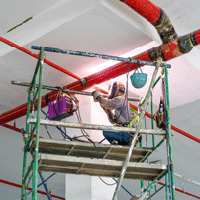Two Workers Die in Scaffold Collapse
November 1, 2018 In late August of this year, two Florida construction workers were fatally injured when the scaffolding they were pouring concrete from collapsed and fell six floors. Although the cause of this particular incident is still under investigation, the Occupational Safety and Health Administration (OSHA) estimates that over 2 million men and women work on scaffolding – and that more than 4,500 are injured and 60 others die in scaffold-related accidents every year.
In late August of this year, two Florida construction workers were fatally injured when the scaffolding they were pouring concrete from collapsed and fell six floors. Although the cause of this particular incident is still under investigation, the Occupational Safety and Health Administration (OSHA) estimates that over 2 million men and women work on scaffolding – and that more than 4,500 are injured and 60 others die in scaffold-related accidents every year.
What are Scaffolds?
There are many different types of scaffolds, which can also be referred to as “staging” or scaffolding. Generally speaking, scaffolds are temporary platforms used to support materials and work crews. More than 65% of the construction industry uses scaffolding for various jobs. Scaffolds are generally constructed from metal, wood, or both, though they can be made from other materials as well.
Scaffolds are either supported or suspended, depending on what type they are. Suspended scaffolds are hung using ropes and other kinds of non-rigid, overhead supports while supported scaffolds have one or more platforms that are held by rigid, load-bearing members, like poles or legs.
Common Hazards Associated with Scaffolds
According to OSHA, there are numerous hazards commonly associated with using scaffolds. These hazards, which can cause both nonfatal and fatal injuries in the workplace include:
- Collapse of the scaffold, resulting from structural instability or too much weight;
- Electrocution due to proximity to overhead power lines;
- Falls from elevated heights, and:
- Being hit or struck by falling tools, work materials, or debris
OSHA provides employers with multiple control measures that are effective in protecting workers against preventable scaffolding-related injuries and deaths. Every worker is entitled to a safe and healthy workplace – and each employer is legally responsible for providing one. Depending on what kind of scaffold workers will be using, employers have to follow certain safety standards and requirements (e.g. criteria for supported scaffolds versus criteria for suspended scaffolding).
Before using scaffolding at work, every worker must be trained to recognize (as well as how to control or decrease) the hazards associated with the type of scaffold they will be using. OSHA has lots of other safety requirements for scaffold use, such as a standard for using scaffolding in inclement weather, as well as various inspection guidelines.
Common Scaffold-Related Injuries
When a worker is on scaffolding, he or she is usually working from an elevated height. Working at height – and falling – increases a person’s chances for sustaining serious and catastrophic injuries, such as irreversible spinal and neck injuries. Other injuries that are commonly associated with scaffold use (particularly in the construction industry) include:
- Traumatic brain injuries;
- Broken bones and fractures, and:
- Concussions
Even with safety requirements in place, some employers fail to take steps to adequately protect their employees. Other times, tragic mistakes happen and someone loses his or her life. If you sustained injuries in a scaffolding-related workplace incident or you know someone who did, you should consider contacting an attorney who can help determine which party is liable. When a person gets hurt at work, filing a workers’ compensation claim can help cover medical expenses and lost wages. If you would like to learn more about filing a workers’ compensation claim, please contact a representative at our firm directly.
Allentown Workers’ Compensation Lawyers at Galfand Berger, LLP Represent Individuals Injured at Work
If you were injured at work, please contact our Allentown Workers’ Compensation lawyers at Galfand Berger. With offices located in Philadelphia, Bethlehem, Lancaster, and Reading we serve clients throughout Pennsylvania and New Jersey. To schedule a consultation, call us at 800-222-8792 or complete our online contact form.
 Google Screened
Google Screened
